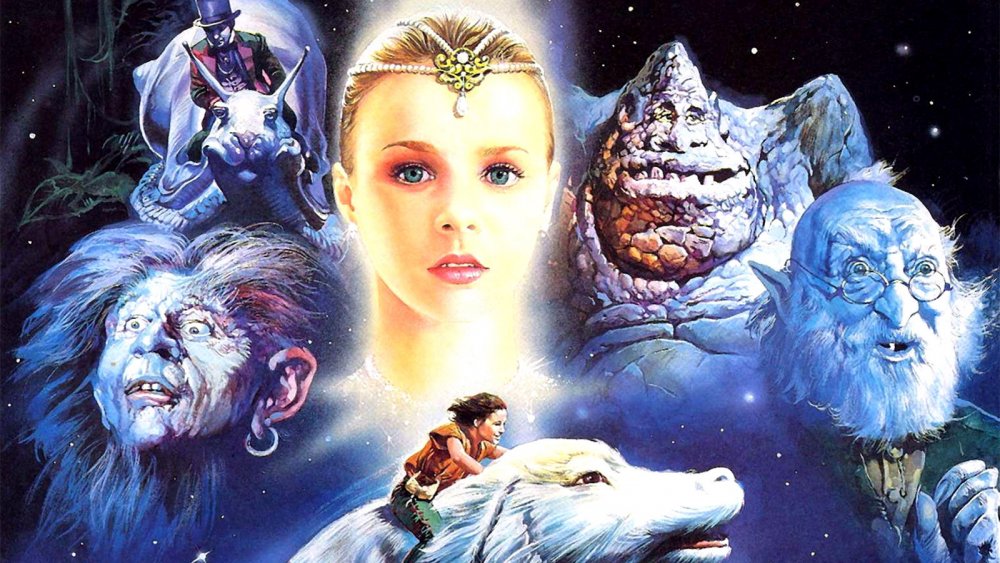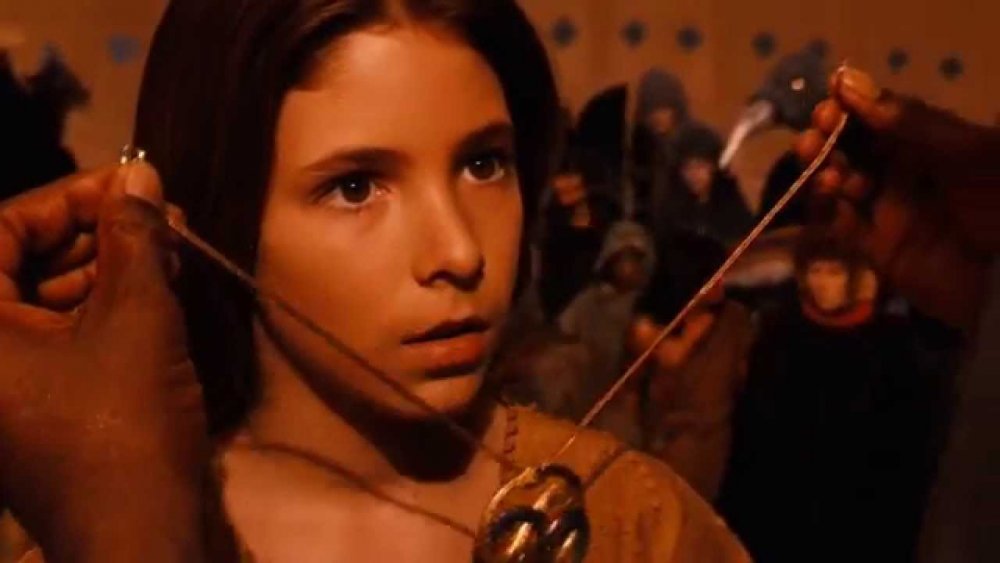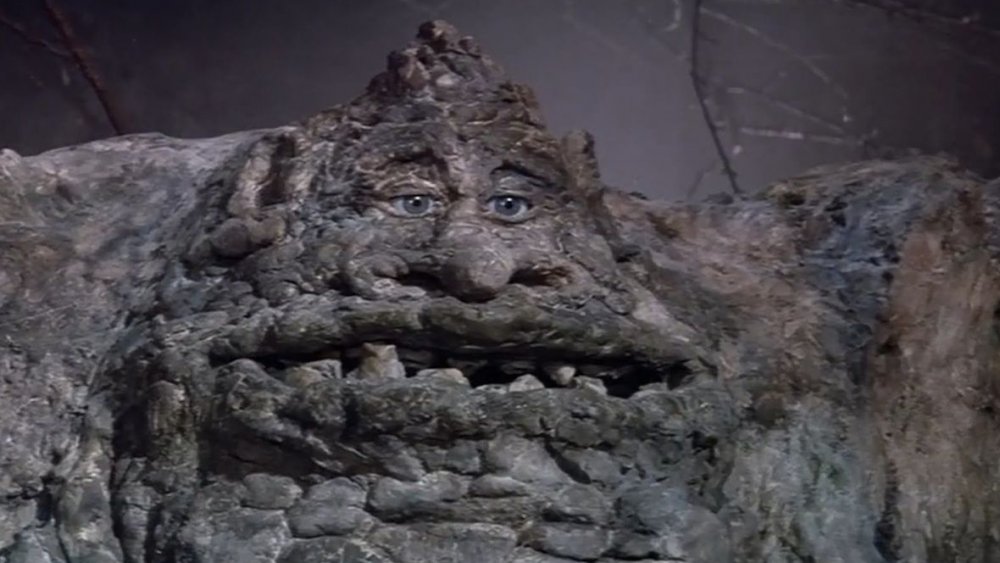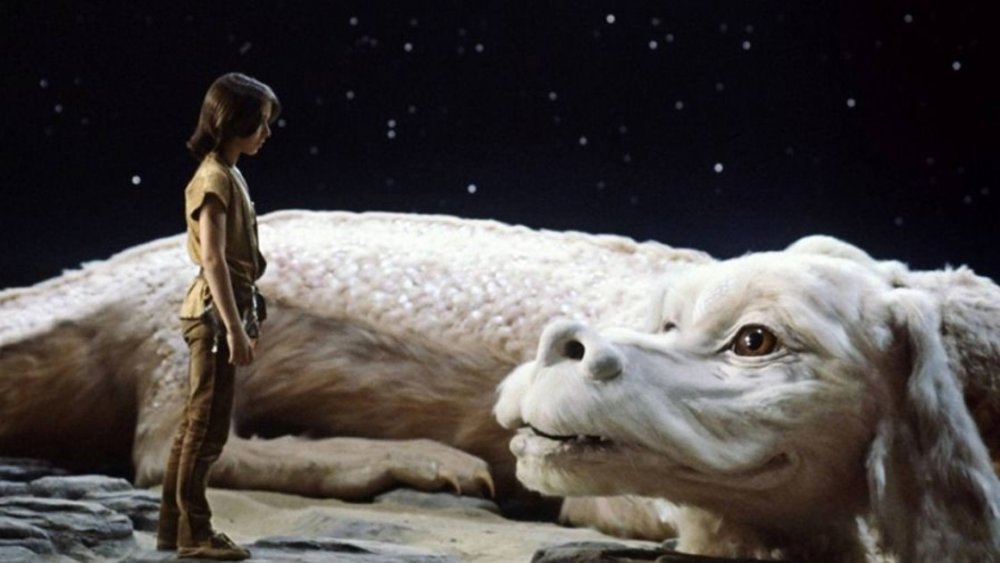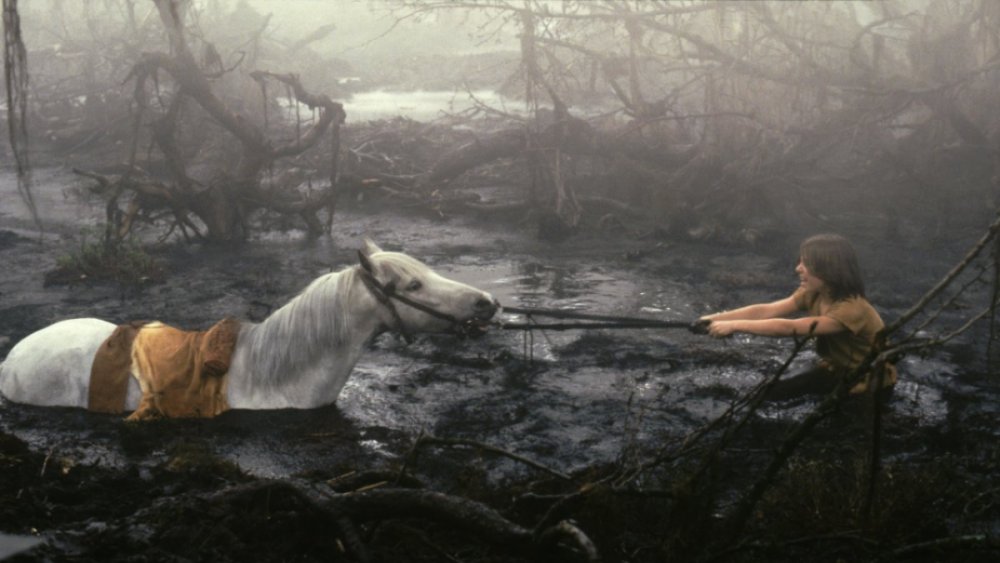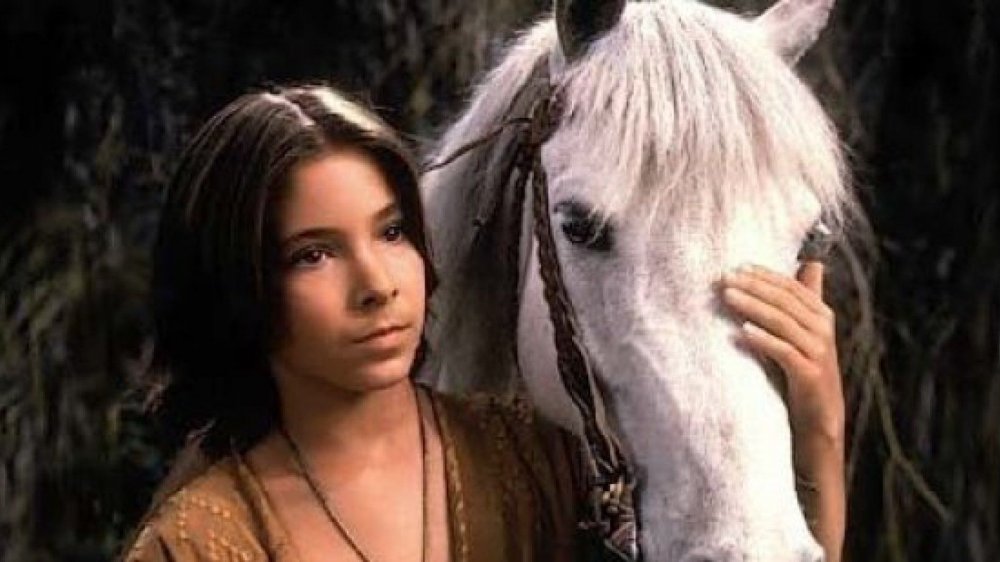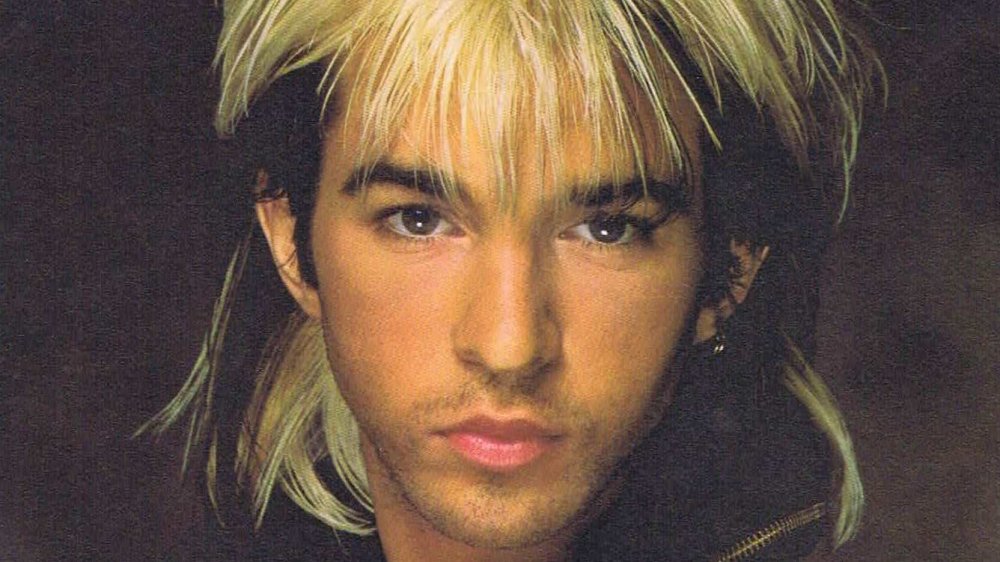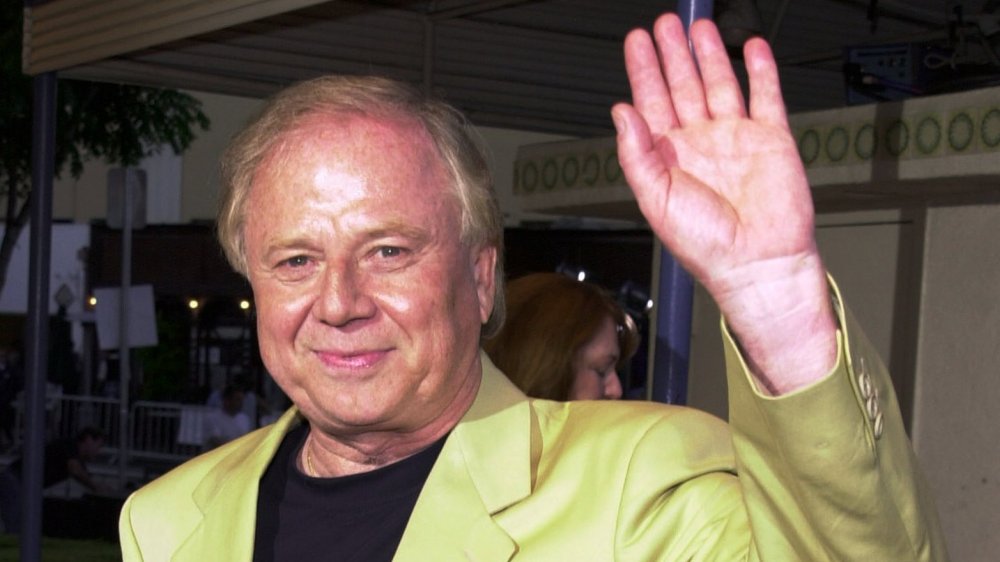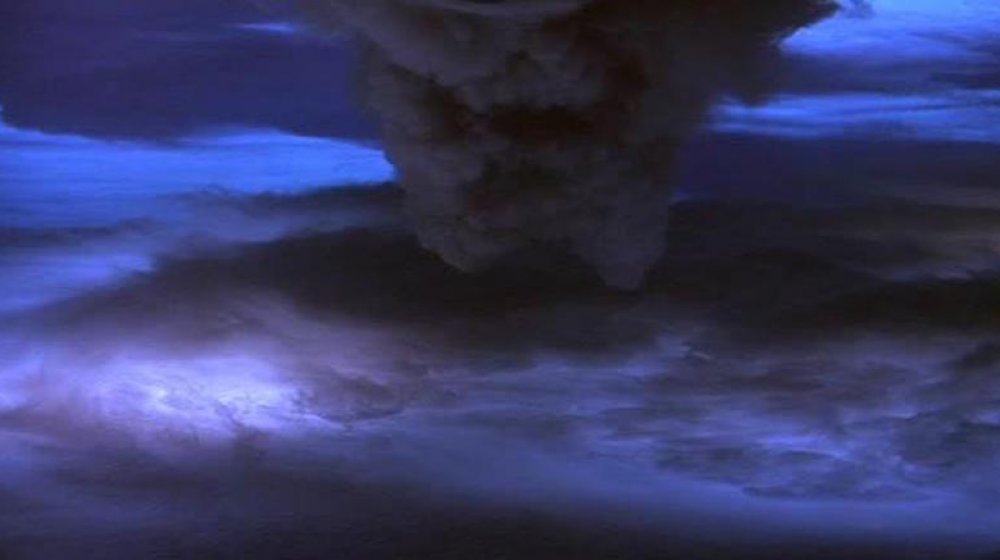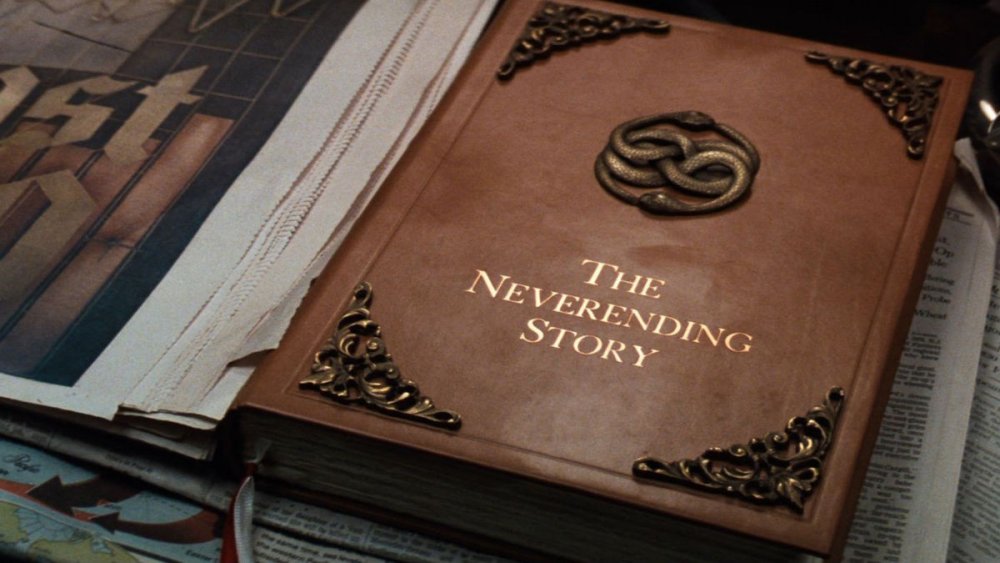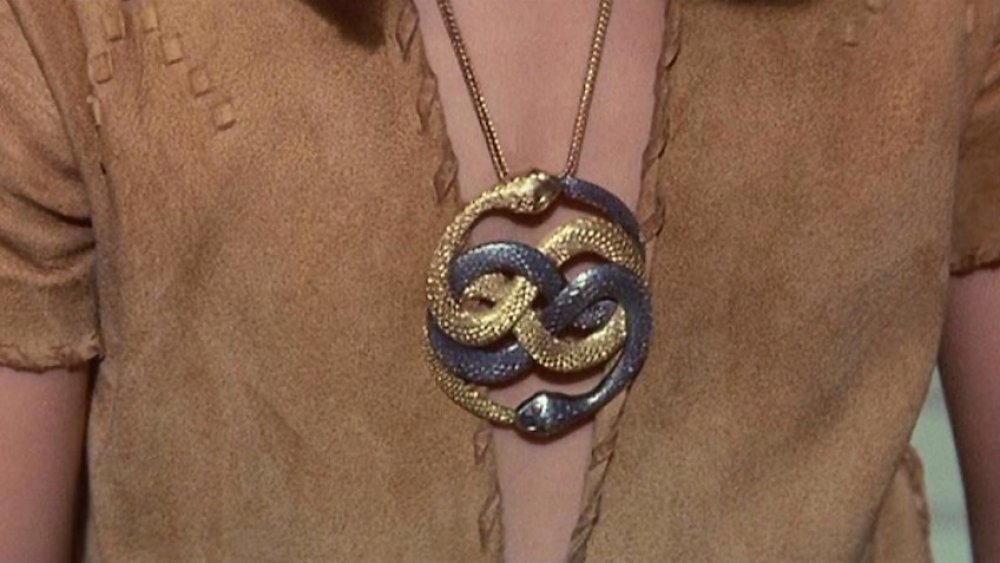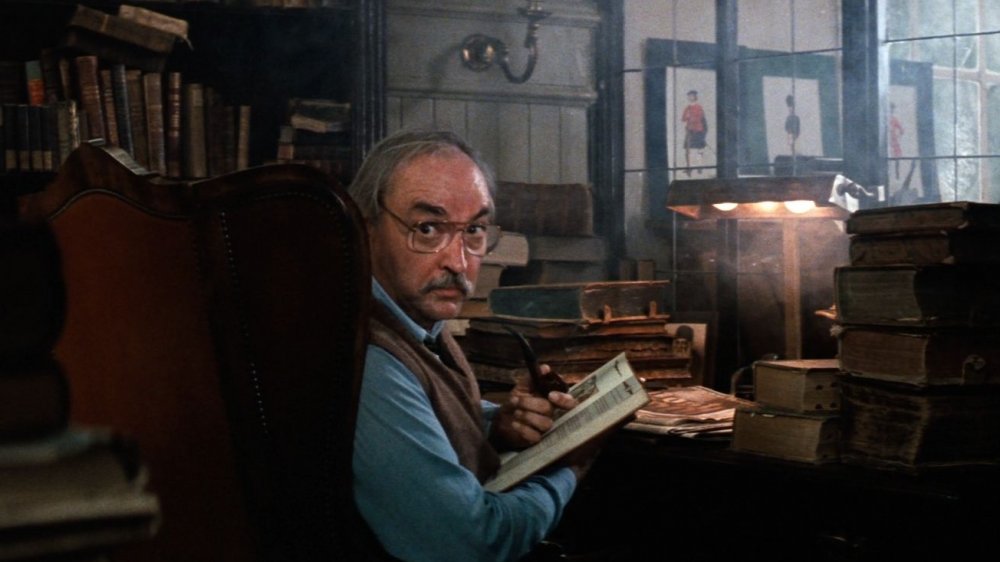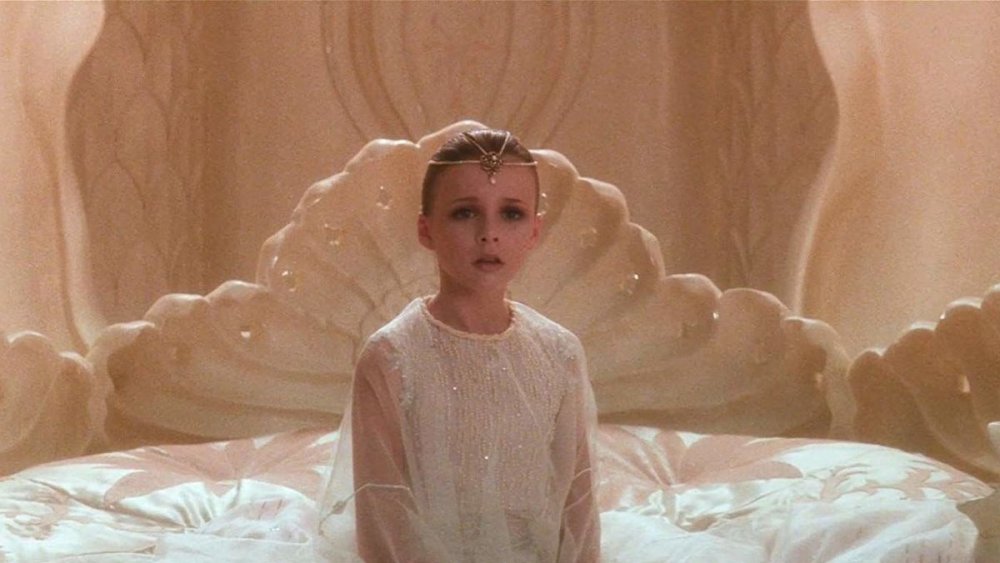The Untold Truth Of The NeverEnding Story
After being tossed in a dumpster by a group of bullies before school and quietly berated by his emotionally distant father at home, young Bastian Balthazar Bux (Barrett Oliver) finds himself in an antique bookshop run by grouchy Mr. Coreander (Thomas Hill). Intrigued by the book the shop's proprietor is reading, Bastian steals, er, borrows it and proceeds to play hooky from school. Before long, while journeying along with the warrior Atreyu (Noah Hathaway) on his quest to save the Childlike Empress (Tami Stronach), Bastian finds himself to be an integral part of The NeverEnding Story too.
Based on Michael Ende's beloved classic novel of the same name, Wolfgang Petersen's film adaptation is treasured by young and older folks alike. (It even had a fresh burst of social and cultural relevance after the touching homage to its theme song in the third season of Netflix's Stranger Things.) This beautiful story about the power of youth and the magic that comes with believing in oneself ended up also being the most expensive movie ever made in German cinema, even though the film itself is in English.
After decades The NeverEnding Story continues to resonate with audiences and its practical special effects have aged the movie wonderfully. Turn around and look at what you see: This is the untold truth of The NeverEnding Story.
Noah Hathaway had to audition many times
As the young warrior Atreyu tasked with saving the Childlike Empress from her impending death, Noah Hathaway brought the entire gamut of emotions to his portrayal. From his intense vulnerability as he loses his best friend Artax to his fierceness in battle against the Nothing's minion Gmork, it's hard to imagine The NeverEnding Story with anyone but Hathaway in the role. But his journey to being cast was nearly as arduous as his journey in the movie.
Talking to Entertainment Weekly for the film's 35th anniversary, Hathaway revealed that he was among 50,000 hopefuls from around the world who auditioned for the part of strong and sensitive Atreyu. He was finally cast, but then original director Helmut Dietl ended up leaving the project, opening the door for Wolfgang Petersen to take over — which meant that Hathaway had to begin the audition process all over again. In total, Hathaway recalls auditioning at least 10 times; ultimately it was his half Native American ancestry and particular look that ultimately cemented him as Petersen's Atreyu.
While Hathaway had been acting long before The NeverEnding Story, afterward he only had a few more screen appearances before mostly retiring from acting. He's now a tattooer and martial artist who has tattooed a whole lot of Auryns over the course of his career.
Falkor, Rockbiter, and Gmork have something in common
The NeverEnding Story is filled with fantastical characters who were brought to life using practical special effects and puppetry. And as hard as it is to conceive of a NeverEnding Story without Noah Hathaway as Atreyu, it's almost weirder to find out that the voices of kindly luckdragon Falkor, limestone-thirsty Rockbiter, and menacing Gmork were all added after primary filming was already finished.
Chatting with Entertainment Weekly, veteran character and voice actor Alan Oppenheimer (He-Man and the Masters of the Universe, Smurfs, Transformers) was first approached by Wolfgang Peterson only to do the voice of Falkor. Oppenheimer flew to Germany and did his work, but wasn't happy with his first try. He went back for a second pass at Falkor, and in the process, Oppenheimer completely fell in love with the movie. Since Petersen had yet to find appropriate voices for the kooky Rockbiter and monstrous Gmork, he had Oppenheimer give it a shot. The result was three distinct characters that you'd never guess were all voiced by the same person.
Oppenheimer's voice also ended up being used as the Narrator, and he's joked that Petersen ended up getting four actors for the price of one. For that, fans of The NeverEnding Story will forever be grateful.
Falkor was huge in real life
Did you even have a childhood if you never imagined what it would be like to ride Falkor through the skies of Fantasia, or on Earth chasing down bullies? But for Atreyu actor Noah Hathaway, the experience left something to be desired; as he told Entertainment Weekly, "Riding Falkor wasn't as glamorous as you might imagine." Falkor was a huge contraption that stood 20 feet in the air and required at minimum 15 people for his various movements. "Sometimes, it would overheat, and it would start going out of control probably once every 20 minutes," Hathaway recalled. "It ended up being like riding a bucking bronco. I just had to hold on for dear life from time to time, but it was fun!"
In the same Entertainment Weekly interview, Director Wolfgang Petersen pinpointed a major reason The NeverEnding Story still resonates so deeply even in the age of HD: "It took a lot of work to have it come out the way it did on film, and I believe that's what gives this movie such a great quality that can be appreciated after all these years. The creatures were so real how they had to interact with the actors, it wasn't like they were just standing in front of this green screen and pretending."
And for those who still dream of riding Falkor, you can do it at Bavaria Film Studios in Germany, where the actual Falkor from the movie is now an exhibit for visitors. There are even sets from The NeverEnding Story you can walk through.
A grim urban legend about the horse playing Artax
As if the scene with Atreyu and Artax in the Swamps of Sadness isn't traumatic enough, Wolfgang Petersen has talked about a horrible urban legend that has persisted through the decades claiming that the horse actually died. This is completely untrue, but that doesn't mean that the two horses who played Artax didn't have a difficult time.
First off, it took the production months to train the horses to pretend to drown even though we never actually see Artax's head go underwater onscreen. After filming, the production even gifted Atreyu actor Noah Hathaway with one of the horses as well as the saddle for all his hard work, but because it was so complicated to ship the horse internationally, Hathaway ended up giving his riding double the horse and it went on to live for 20 years in Germany after filming wrapped.
Hathaway continues to joke that he feels responsible for so many peoples' childhood traumas because of that heartbreaking scene with Artax, quipping that he feels like he's giving them therapy at his convention appearances.
Noah Hathaway was badly injured several times
While no horses were hurt during the filming of The NeverEnding Story, the same can't be said for Noah Hathaway. Even before primary filming began, one of the horses fell on him and he ended up with a broken back. He was in traction for an entire month and they weren't sure if he would be healed in time to actually play Atreyu. After everything he'd been through to land the part, losing it before even beginning would have been heartbreaking.
Luckily, Hathaway healed up quickly — even though he would be injured a few more times while working on the set, in particular during the Swamps of Sadness scene with Artax and Atreyu's meeting with Morla the Ancient One. Those scenes took the production two grueling months to film and saw Hathaway constantly soaking wet and covered in muck for much of his time on set.
Because of the initial accident, unfortunately Hathaway now has titanium screws in his spine and ongoing back issues because of that horse crushing him on The NeverEnding Story set.
The German version of the movie doesn't have the same score/soundtrack
Something even the most devoted NeverEnding Story fan might not know is that there are essentially two different versions of the movie out in the world. The German version was fully scored by Klaus Doldinger, but as Wolfgang Petersen considered his vision going international, he brought in songwriting and composer Giorgio Moroder (American Gigolo, Midnight Express, Scarface) to add some final flourishes that would become the score of The NeverEnding Story North Americans are most familiar with.
Another huge difference is that only the international version of the movie has its famous earworm of a theme song, sung by pop star Limahl. A minor hit in the U.S. at the time, the song has recently resurfaced in the pop culture consciousness thanks to Stranger Things — but it almost wasn't included in the film because of the then-president of EMI Records who absolutely hated it. However, because Moroder was so impressed with Limahl after meeting him, he went to bat for the singer and the tune ended up opening the movie in a huge way.
Director Wolfgang Petersen was a perfectionist
Unlike many of its contemporaries, The NeverEnding Story has aged well. One of the reasons is its excellent use of practical effects that have only gotten crisper with the rise of high-definition screens. Another is the fact that Wolfgang Petersen was an absolute perfectionist and required no shortage of multiple takes in order to get the movie exactly right.
Speaking to The News Tribune, Noah Hathaway noted that a three-month filming schedule ended up turning into a whole year because Petersen kept requiring take after take after take. Hathaway also noted that at the time Petersen wasn't entirely comfortable with his English, which could have contributed to the need for so many takes.
Hardcore fans of The NeverEnding Story will have noticed that some of the actors in the English version also appear to be dubbed. This is because many of them were also German and didn't speak English at all. They read their lines in German, and American voice actors translated the dialogue for the American version.
How the Nothing was conceived for the screen
The terrifying threat to Fantasia — and the human world as well — was a dreadful void called the Nothing. When asked to describe what was happening to his home and why he needs the Childlike Empress' help, Rockbiter describes a lake that just disappeared. "Did the lake dry up?" Teeny Weeny (Deep Roy) asks. "No, it just wasn't there anymore. Nothing was there anymore. Not even a dried up lake." "A hole?" Teeny Weeny replies, to which Rockbiter responds, "No, a hole would be something. Nah, it was nothing. And it got bigger and bigger. First there was no lake anymore and then finally, no rocks."
The Nothing was an esoteric threat, but also very real in the world of The NeverEnding Story. Talking to SciFi Now, the movie's special effects coordinator Brian Johnson (Alien, Star Wars) explained that he conceptualized the Nothing in the film by essentially using the horizon as a starting point to then showing the natural world disintegrating and disappearing into it. This was one of the few moments when camera tricks were utilized — the Nothing's unique effects are depicted as colors splash across the sky and the illusion of nothingness takes center stage onscreen.
The author of the book absolutely hated the movie
Michael Ende's The NeverEnding Story was a global bestseller after its 1979 publication. When the book's rights were sold for the film adaptation, Wolfgang Petersen was supposed to write the script with Ende himself, but this is where problems with the production began — Ende didn't understand that his enormous story would need to be altered in order to fit a two-hour running time.
"The story was sacred to him," Petersen told Entertainment Weekly, and so Petersen ended up co-writing the script with Herman Wiegel instead. When Petersen sent over the final draft, Ende was so furious at how it had turned out that he tried to sue to have production halted. The movie came out anyway, and unsurprisingly, Ende hated it.
Ende called the film "disgusting" and "revolting," and even went so far as to accuse the production of ruining his story just for the money, claiming they didn't understand the core themes of the book. He also had these scathing words to say about the first gate Atreyu must pass to save the Empress: "The Sphinxes are quite one of the biggest embarrassments of the film. They are full-bosomed strippers who sit there in the desert." Ende went to his grave in 1995 still hating the movie based off his beloved book.
Stephen Spielberg owns the Auryn necklace prop
Wolfgang Petersen was no stranger to critically acclaimed films, having directed Das Boot before he took on The NeverEnding Story. But he wasn't familiar with making an English-language movie that would resonate with English-speaking audiences; his previous work that had almost exclusively been in German. Through Das Boot, Petersen had connected with Steven Spielberg, and they often chatted about filmmaking and other things over the phone. Spielberg was in the early stages of work on Schindler's List, and Petersen helped him scout different filming locations.
In return, Spielberg was more than happy to take a look at Petersen's working version of The NeverEnding Story, and he helped cut seven minutes of footage that he felt would pace the movie better for international audiences in particular North Americans. Petersen has said that Spielberg admitted he learned those tips through George Lucas, who helped Spielberg develop his own sense of pacing.
Because of Spielberg's edits, the American version of the movie is seven minutes shorter than the German one. As thanks for his notes and kindness, Petersen gave Spielberg one of the most coveted of the film's props: the Auryn necklace that Atreyu wears. Spielberg has the Auryn to this day.
You can catch theater productions of the story all over the world
The NeverEnding Story is an elaborate fantasy tale with lots of wild creatures and moving parts, so it would seem safe to assume that a stage production would require the huge scope of a Broadway show like Wicked in order to work. Instead, in 2006 Imagination Stage and the Seattle Children's Theater commissioned playwright David S. Craig to adapt the movie for small stages.
The NeverEnding Story: Atreyu and the Great Quest is licensed for stage productions in the USA, Canada, New Zealand, South Africa, and Australia, and has seen runs in multiple major cities. Productions have taken place in Los Alamos, Ottawa, Washington DC, Toronto, and many more, often to rave reviews. Like the movie on which it is based, many of the stage productions rely not just on puppetry to recreate the beloved characters, but also often the audience's imagination to help fill in the imagery that didn't make it on stage.
There will never be a remake
Because of Michael Ende's absolute hatred of the first final product of his novel adapted to screen (he didn't live to see the two sequels), Wolfgang Petersen has said that the rights to the story are tied up in litigation with no end in sight. And he's okay with that — as is the voice of Falkor/Rockbiter/Gmork, Alan Oppenheimer, as well as the Childlike Empress herself, Tami Stronach.
"I like the way the film is, with all its old fashioned charm," Petersen said. "Just leave it alone." Oppenheimer agreed, adding, "I think they need to leave it alone; it doesn't need a remake."
While Stronach has admitted she would enjoy watching a remake, she pointed out, "I think the film is an invitation to grow the space of making and creating. Hopefully, if Hollywood diversifies and there are more women directors, and more minorities writing scripts, the message of the film will be the ultimate winner here. So, I don't think we need to remake this, but I think we need to keep growing the space for everyone." The Childlike Empress doesn't need a new name anymore, now she wants inclusion and representation onscreen. Go on then, creatives, listen to the Empress and do what you dream.
